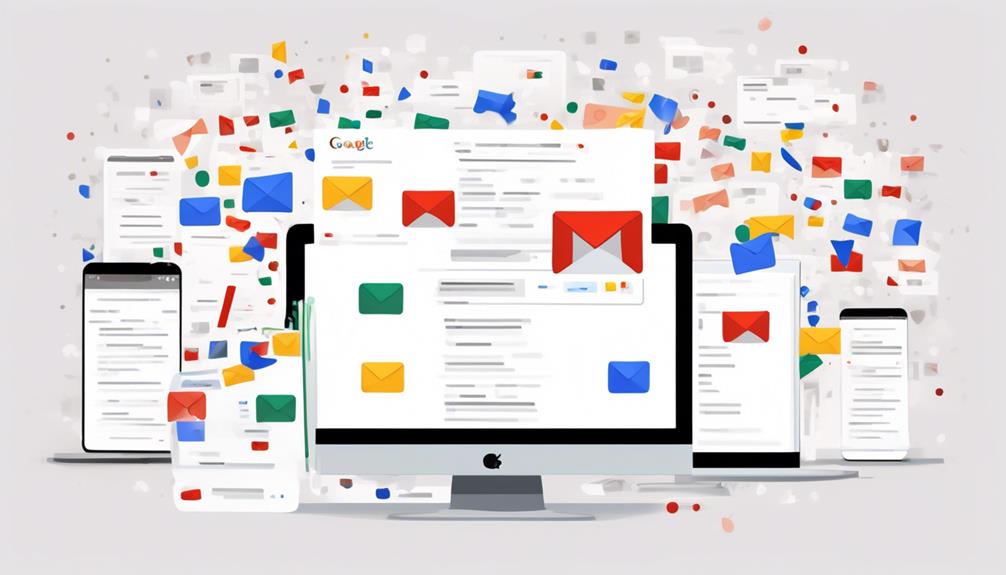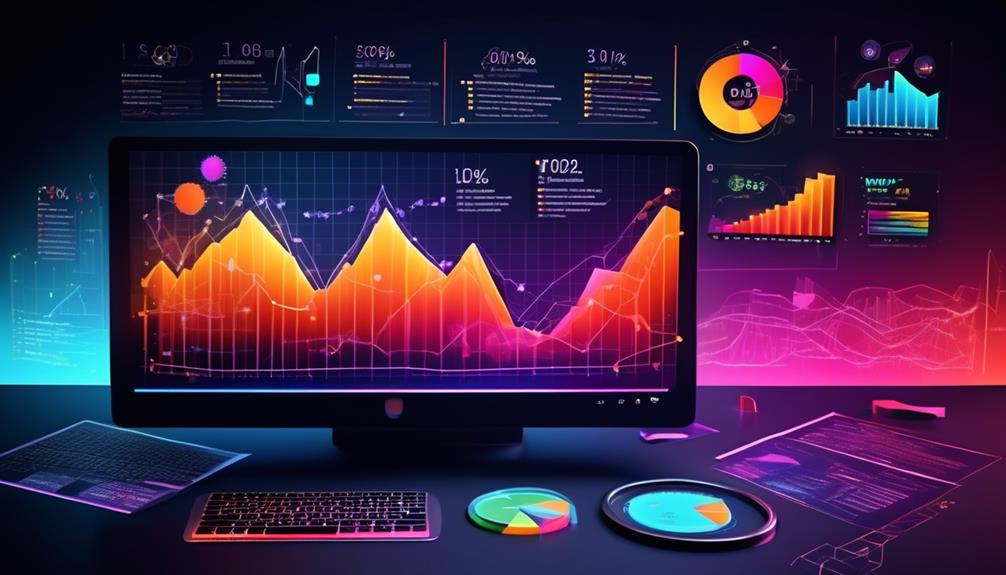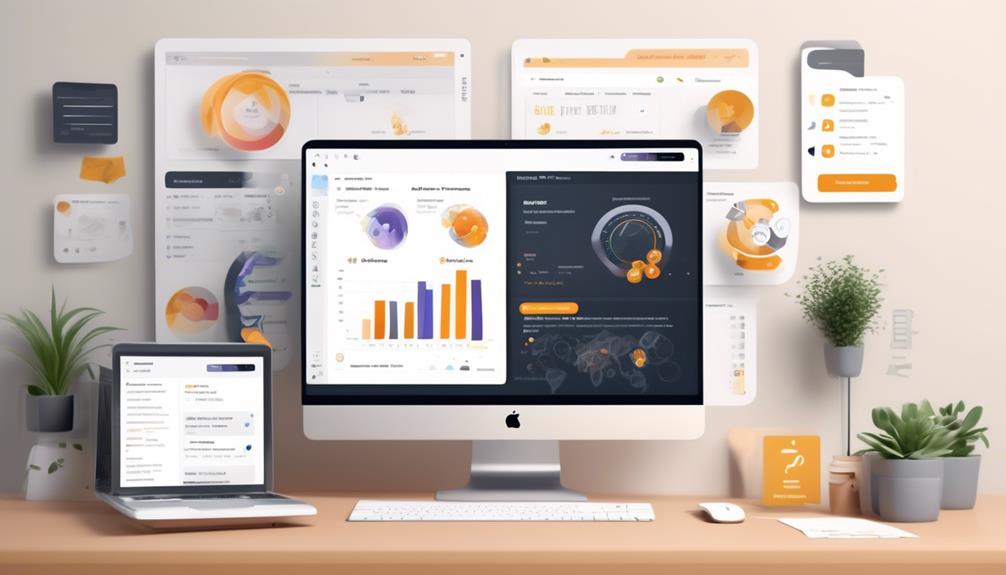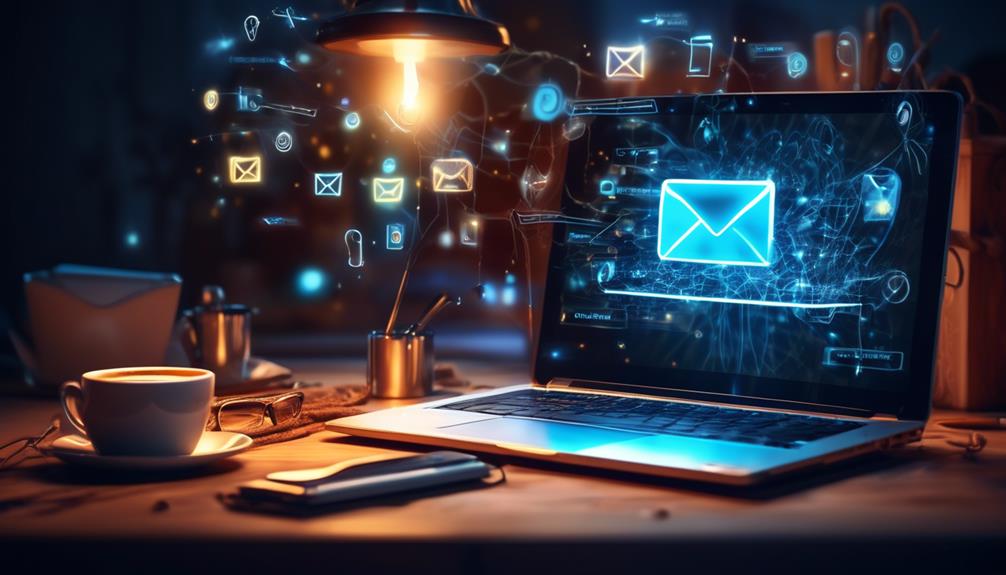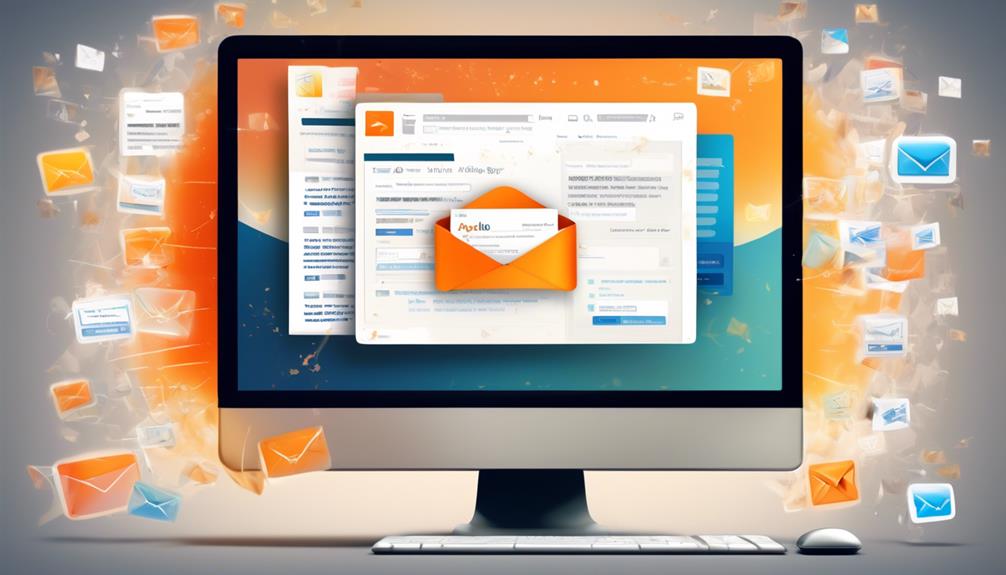Okay, so we’ve all been there – setting up a new email account and feeling eager to start sending out important emails right away. But hold on a second, because there’s something important called Google Email Warm-up that we should discuss.
It's not just a formality; it's a crucial step in establishing a solid foundation for our email communication. Trust me, you'll want to stick around to find out how this process can make or break our sender reputation and the success of our email campaigns.
Key Takeaways
- Email warm-up is important for establishing trust and improving deliverability in Google accounts.
- Gradually increasing email volume over time and adhering to Google's terms and guidelines are best practices for successful warm-up.
- Manual warm-up processes, including using tools or Chrome extensions, can help reduce the risk of being flagged as spam.
- Monitoring engagement metrics and seeking help from experts are essential for maintaining effective email campaigns and navigating the evolving landscape of email warm-up.
Importance of Email Warm up
Email warm-up is a critical step in establishing trust and enhancing the reputation of our email account. It plays a pivotal role in gradually increasing the volume of emails sent, thereby improving deliverability and inbox placement. This strategic approach is vital for email marketing success, as it helps avoid triggering spam filters and ensures that our messages land in the recipients' main inbox.
By adhering to Google's rules and gradually ramping up our email list activity, we can avoid account suspension for suspicious activity. While manual warm-up may be more time-consuming, it's essential for achieving high inbox placement and complying with Google's policies.
Additionally, gaining Gmail API access can streamline the warm-up process, providing valuable insights and control over our email deliverability. Moreover, configuring SPF, DKIM, and DMARC DNS records further enhances our email reputation and ensures optimal deliverability.
Understanding the importance of email warm-up and implementing best practices is crucial for maintaining a positive sender reputation and achieving successful email marketing campaigns.
How Email Warm up Works

Let's talk about how email warm-up works and the benefits it offers.
The warm-up process involves gradually increasing email activity to build trust and improve deliverability.
We'll explore the specific steps involved in the warm-up process and the positive impact it has on inbox placement and account security.
Warm up Process
Utilizing an automated system, warmup tools gradually engage and interact with emails to build trust for an email account and improve its reputation. This process involves sending, opening, and responding to emails, training algorithms to recognize valuable and anticipated emails.
By doing so, the warm-up tool helps increase deliverability and establish trust for a new email account. It also minimizes the risk of account suspension for suspicious activity.
However, it's crucial to note that recent changes in Google's policies have led to the ban on automated warm-up tools for Gmail accounts. This necessitates a shift towards manual email warm-up and a focus on other aspects of email deliverability.
Adhering to these changes and seeking expert assistance can help ensure the effectiveness of cold email campaigns within the updated policy guidelines.
Benefits of Warming up
With the recent ban on automated warm-up tools for Gmail accounts, our approach to email deliverability must now adapt to manual warm-up processes and alternative email providers. Warm-up tools are essential for building trust in Google accounts, increasing deliverability, and avoiding triggers that could lead to spam filters.
By gradually increasing email volume and monitoring statistics, we can ensure that our emails reach their intended recipients. Customizable schedules and live daily warmup stats offered by popular warm-up tools are crucial for tracking progress.
Although Google's ban presents challenges, manual warm-up and other email providers offer viable alternatives. Implementing technical settings, updating contacts, personalizing subject lines, and employing proper targeting techniques are vital for achieving quality outreach.
Adapting to these changes will be key to maintaining effective email deliverability.
Best Practices for Email Warm up
We will now address the best practices for email warm-up, including timing for warm-up, email domain reputation, and gradual email volume.
These practices are crucial for establishing a positive sender reputation and improving deliverability.
Timing for Warm-up
Starting the warm-up process for email delivery involves gradually increasing the volume of emails over time to effectively train algorithms and simulate a natural cadence. This is crucial for successful cold email outreach, as it helps in landing emails in the main inbox. Below is a table showcasing a sample timeline for warming up email accounts:
| Week | Number of Emails Sent |
|---|---|
| 1 | 50 |
| 2 | 100 |
| 3 | 200 |
| 4 | 300 |
Email Domain Reputation
As we progress to the discussion of 'Email Domain Reputation' in the context of best practices for email warm-up, the gradual increase of email volume serves as a crucial foundation for establishing a positive domain reputation. This is essential for maintaining a good sender reputation and ensuring email deliverability.
To effectively warm up your email domain and enhance its reputation, consider the following key strategies:
- Gradually increase the number of emails sent per day to simulate a natural email sending pattern and avoid triggering spam filters.
- Adhere to Google's terms and guidelines to prevent potential account suspension and maintain trust with the world's largest email service provider.
- Implement manual warm-up techniques, such as personalized messages and plain text emails, to enhance domain reputation and improve deliverability.
Gradual Email Volume
Implementing a gradual increase in email volume is critical to simulating a natural sending pattern and enhancing domain reputation during the email warm-up process. This strategy is vital for establishing trust and improving deliverability, especially for new email accounts. It's essential to carefully manage the volume of emails sent to avoid triggering spam filters and damaging domain reputation. Here's a table to emphasize the importance of gradual email volume in the warm-up process:
| Key Point | Importance |
|---|---|
| Simulating Natural Cadence | Trains algorithms, builds trust, and improves deliverability |
| Avoiding Spam Filters | Prevents triggering filters, protecting domain reputation |
| Establishing Trust | Critical for new email accounts, enhancing domain reputation |
Adhering to best practices for gradual email volume is crucial for the success of cold email campaigns, especially considering the recent limitations on automated warm-up services for Google accounts.
Manual Email Warm-up Process

We consistently find that manual email warm-up is now an indispensable practice due to the discontinuation of the automated warm-up feature for Google accounts. This shift necessitates a strategic approach to warm-up new and existing email accounts.
To adapt to this change, we recommend embracing the manual email warm-up process and incorporating the following key strategies:
- Utilize an Email Warmup Tool: Consider using email warm-up tools or Chrome extensions designed to simulate natural email sending patterns. These tools can help in gradually increasing the volume of emails sent from a new account, thus reducing the risk of being flagged as spam by internet service providers.
- Gradually Increase Email Volume: Implement a gradual increase in the volume of outgoing emails from new accounts. This gradual escalation can assist in building a positive sending reputation and reducing the likelihood of emails being filtered as spam.
- Seek Expert Guidance: Engage with experts who specialize in email deliverability to gain insights into best practices and alternative strategies for manual email warm-up. Their expertise can provide valuable guidance in navigating the evolving landscape of email warm-up for Google accounts.
Embracing manual email warm-up processes and leveraging appropriate tools and expertise will be crucial in maintaining effective cold email campaigns amidst the discontinuation of automated warm-up features for Google accounts.
Alternatives to Email Warm up

With the discontinuation of automated warm-up features for Google accounts, exploring alternative strategies for email warm-up becomes imperative for maintaining deliverability and engagement with recipients. Embracing manual email warm-up is crucial in this changing landscape.
While more time-consuming, manual warm-up is essential for landing emails in the main inbox, especially with the diminishing prevalence of automated warm-up services. It's recommended to start embracing manual warm-up now to adapt to these changes effectively.
Additionally, doubling down on other aspects of email deliverability is essential. Personalizing messages, opting for plain text emails, verifying email addresses, and avoiding salesy language and spam words can significantly improve deliverability in the absence of warm-up tools. If needed, seeking help from experts can aid in adapting to the new email warm-up restrictions and maintaining effective email campaigns.
Consideration can also be given to using alternative email providers for warm-up. Zoho Mail, Yahoo!, and Outlook are viable options for warm-up, enabling users to continue their email warm-up strategies despite the ban on automated services. After gradually increasing email volume and sending a small number of emails to engaged contacts, it's important to conduct a deliverability test to monitor the effectiveness of the chosen warm-up strategy.
Handling Google Email Warm-up Changes

Upon the discontinuation of automated warm-up features for Google accounts, strategizing to adapt to the upcoming changes becomes paramount for maintaining email deliverability and engagement.
As we navigate through these changes, it's crucial to understand how to handle the Google email warm-up adjustments effectively. Here are three essential strategies for handling the changes:
- Gradually Ramp Up Sending: With the automated warm-up feature no longer available, it's essential to gradually ramp up the volume of emails sent to Google accounts. This approach helps in building a positive reputation with Google and ensures that emails are delivered to the main inbox.
- Monitor Engagement Metrics: With the changes in warm-up features, closely monitoring engagement metrics such as open rates, click-through rates, and spam complaints becomes even more critical. This data provides insights into how Google is treating the emails and helps in adjusting the sending strategy accordingly.
- Seek Professional Guidance: Adapting to the changes may require expert guidance. Seeking assistance from professionals who specialize in email deliverability can provide valuable insights and help in implementing alternative strategies within Google's policy guidelines.
Frequently Asked Questions
How Long Does It Take to Warm up Gmail?
It typically takes time to warm up a Gmail account, involving a gradual ramp-up of emails and monitoring warmup statistics.
Google's automated warm-up features for Gmail accounts will no longer be supported starting February 6, 2023.
Adhering to Google's rules is essential to maintain Gmail API access and ensure email deliverability, especially with the ban on warm-up tools.
Manual warm-up, personalized messaging, and using alternative email providers like Zoho Mail or Outlook are recommended strategies to adapt to the changes.
What Does Email Warm up Mean?
Email warmup is a process that involves gradually building trust for a new email account. It is done by simulating a normal email cadence, which helps train algorithms and increase deliverability. The main goal of warmup is to establish trust with email providers, allowing the account to send its full limits and improve inbox placement. This is crucial for preventing account suspension and training email clients to anticipate larger campaigns.
There are several strategies that are essential for improving email deliverability during the warmup process. Manual warmup is one such strategy, which involves manually sending a small number of emails each day and gradually increasing the volume over time. This helps build trust with email providers and prevents sudden spikes in sending activity that could trigger spam filters.
Personalized messaging is another important strategy for warmup. By sending personalized and relevant emails to recipients, it helps improve engagement and reduces the likelihood of emails being marked as spam. This can be done by segmenting the email list and tailoring the content to each specific group.
In addition to manual warmup and personalized messaging, adherence to technical settings is also crucial. This includes properly configuring the email infrastructure, such as SPF, DKIM, and DMARC, to ensure that the emails are authenticated and trusted by email providers. It also involves monitoring email deliverability metrics and making necessary adjustments to improve performance.
When Should You Stop Warm up Emails?
We should stop warm-up emails when Google's warm-up and recovery feature for accounts is no longer available after February 6th, 2023.
It's time to make the switch if ongoing warm-up and recovery for Google email addresses or domains are automatically turned off.
Recognizing the need to stop warm-up emails becomes crucial when warm-up tools are no longer compliant with Google's terms and risk losing Gmail API access.
Embracing manual warm-up strategies is essential as automated services may no longer be viable.
Do Email Warmup Services Work?
Yes, email warmup services work by gradually ramping up email activity to build trust with email providers. This process helps improve deliverability and establishes credibility for new accounts, ultimately minimizing the risk of suspension.
Embracing manual warmup is recommended, as it aligns with current trends and ensures emails land in the main inbox. Following Google's rules is crucial for maintaining a positive sender reputation and maximizing the effectiveness of warmup strategies.
Can you provide a guide for Google Email Warm up?
If you’re looking to improve your email deliverability and reputation, implementing an email warm up guide is essential. By gradually increasing your sending volume and consistently engaging with recipients, you can build trust with email providers and ensure your messages land in the inbox, not the spam folder.
Is there a way to integrate the Email Warm up API with Google Email Warm up?
Yes, there is a way to integrate the Email Warm up API with Google Email Warm up. By utilizing the email warm up API, you can enhance the deliverability and inbox placement of your emails sent through Google Email Warm up. This integration allows for more effective and efficient email warm up processes.
Conclusion
In conclusion, email warm-up is crucial for establishing a positive sender reputation and improving deliverability for new Google email accounts.
While it may seem like a time-consuming process, the long-term benefits far outweigh the initial effort.
Some may argue that manual warm-up is too labor-intensive, but the trust and reliability gained through this process are invaluable for successful email campaigns.
It's a strategic investment that pays off in the long run.
